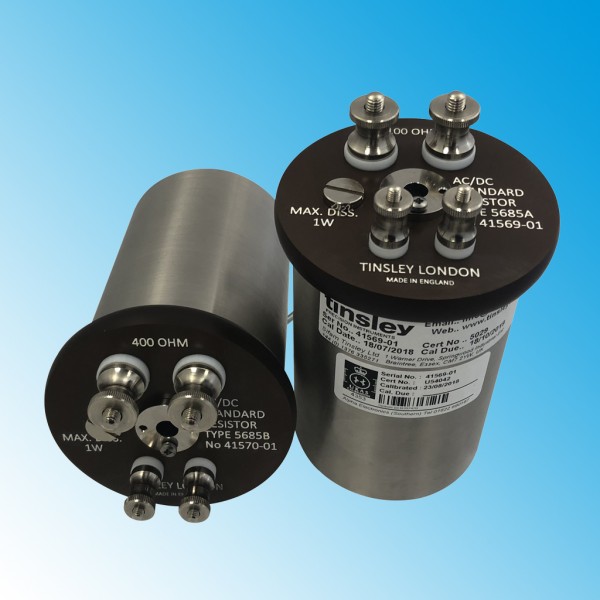Standard Reference Resistors
The design of these Standard Resistors is based on work carried out over several years with co-operation of the National Physical laboratory. The design originated with F. J. Wilkins of the N.P.L. and has evolved as the result of many tests on stability and temperature coefficient using both a.c. and d.c. Some of the original design features have been discarded in the interests of simplicity, notably the horns which are no longer considered necessary.
The aim has been to produce four-terminal Standard Resistors to the highest specification, suitable for a.c. and d.c. work up to a frequency of 1592 Hz. 1 Ohm to 10,000 Ohms. The Resistors are made from a specially selected alloy having a low temperature coefficient mounted in a strain free manner on formers made from material or low dielectric loss but of high mechanical stability. All the connections are welded. Prolonged heat treatment of the elements ensures long term stability and low temperature coefficient of resistance.
The elements are hermetically sealed in stainless steel containers which are filled with dry oil (Castro! Whitemor WOM14). Provision is made for inserting a thermometer but the resistors are intended to be used in an oil bath which is temperature controlled.
Maximum dissipation for the Resistors is 1 Watt but the highest performance will be obtained with a dissipation of 10 milli-Watts which is the ideal working condition. No harm will occur if the dissipation is increased to 1 watt but self heating will take effect after a few minutes. Since the introduction of these Standard Resistors they have been adopted by National and Major Industrial Standards Laboratories as their primary standards. Information obtained from these laboratories over the past twenty five years indicate their exceptional high stability.
For example, tests have shown that resistors of this type are stable to within 1 ppm over a period of ten years.

General
APPLICATIONS
- Primary standards for voltage and resistance in calibration laboratories worldwide
- Calibration reference for resistance and temperature bridges, such as ohmmeters and AC or DC temperature bridges
SPECIAL FEATURES
- High accuracy
- Excellent long-term stability
- Low temperature coefficient
- Rugged stainless steel construction
- Resistance range 1 to 10’000 Ohms
- Frequency dependence 1 ppm up to 1,592 Hz (Model 5685
Ordering Codes
| Tinsley Model Number | Description |
| 5685A1 | Premium Resistor: 1 Ohm 2ppm |
| 5685A2 | Premium Resistor: 10 Ohm 2ppm |
| 5685A3 | Premium Resistor: 25 Ohm 2ppm |
| 5685A4 | Premium Resistor: 100 Ohm 2ppm |
| 5685A07 | Premium Resistor: 300 Ohm 2ppm |
| 5685B24 | Premium Resistor: 400 Ohm 2ppm |
| 5685B16 | Premium Resistor: 500 Ohm 2ppm |
| 5685B1 | Premium Resistor: 1K Ohm 2ppm |
| | |
| 5695R1 | Standard Resistor: 1 Ohm 5ppm |
| 5695R10 | Standard Resistor: 10 Ohm 5ppm |
| 5695R25 | Standard Resistor: 25 Ohm 5ppm |
| 5695R100 | Standard Resistor: 100 Ohm 5ppm |
| 5695R300 | Standard Resistor: 300 Ohm 5ppm |
| 5695R400 | Standard Resistor: 400 Ohm 5ppm |
| 5695R500 | Standard Resistor: 500 Ohm 5ppm |
| 5695R1000 | Standard Resistor: 1K Ohm 5ppm |
| | |
| 5686A | DC Standard Resistor 0.001 Ohm 0.02% |
| 5686B | DC Standard Resistor 0.01 Ohm 0.01% |
| 5686C | DC Standard Resistor 0.1 Ohm 0.002% |
| | |
| 5615A | High Resistance Standard Resistor - 100k Ohms 10ppm |
| 5615B | High Resistance Standard Resistor - 1M Ohms 20ppm |
| 5615C | High Resistance Standard Resistor - 10M Ohms 20ppm |
| | |
| 5648 | Temperature Controlled Enclosure |
